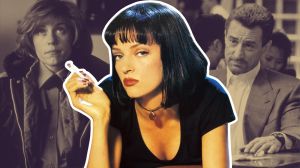Horror has long had a place on the small screen, with two of the biggest brands in pop culture currently being The Walking Dead and Stranger Things. These series offer audiences not only their fair share of frights, but also compelling drama that lasts multiple seasons, allowing audiences to see how these horrifying scenarios affect beloved characters.
Videos by ComicBook.com
Longform horror stories aren’t the only types of horrors that have connected with viewers, as anthological horror series cater to viewers with potentially shorter attention spans or allow more accessible entry points for those of us who can’t commit to multiple seasons of a series. With The Walking Dead entering its ninth season, it can be a daunting task to catch up for those of us who haven’t been devout fans from the beginning.
Additionally, anthologically-structured horror shows often omit cliffhangers, allowing an entire storyline to be wrapped up in one season or even one episode.
For those of you who prefer enjoying more digestible horror stories, scroll down to see our picks for best anthology horror TV series!
‘Alfred Hitchcock Presents’
Alfred Hitchcock is considered by many to be one of the greatest horror filmmakers of all time, a reputation which is aided by his contributions to television. Alfred Hitchcock Presents was hosted and produced by the filmmaker, with each episode delivering audiences drama, thriller, and mystery stories.
Debuting in 1955, the series is relatively tame as far as the more gruesome stories it could offer audiences, but what it lacked in violence it more than made up for in storytelling and performances.
The filmmaker may have only directed 17 of the more than 260 episodes, but playing the role of host on the series allowed the filmmaker to serve as a curator of each tale, cementing himself in the annals of horror.
‘The Twilight Zone’

Thanks in part to the success of Alfred Hitchcock Presents, Rod Serling created The Twilight Zone to offer audiences tales of horror as well as science fiction and any other bizarre genre he cooked up. While the creativity on display in the series matches the best horror writings of all time, Twilight Zone had a more formulaic twist to its narrative, as many of its stories featured a shocking ending or reveal that had a morality lesson for the main character.
Serling and his series set the standard for the horror anthology for many audiences, leading to Serling also developing the horror anthology series Night Gallery, with Twilight Zone being revived in the ’80s as well as a contemporary incarnation currently being developed by Get Out filmmaker Jordan Peele.
‘The Outer Limits’
Given its tendencies to deliver audiences compelling science fiction stories, The Outer Limits is often compared to The Twilight Zone. Thanks to the quality of the latter, this is a welcome comparison, though the two series do have distinct differences.
While Twilight Zone would often employ a sense of whimsy and humor into its narratives, Outer Limits was often a much more straightforward science fiction series that tackled more sophisticated corners of science fiction. The morality twists of Twilight Zone were often dropped in Outer Limits, though the series did often include unexpected twists.
Another big difference is that, while Twilight Zone went on to earn hundreds of episodes, Outer Limits lasted only 50 episodes, but still managed to deliver full-blown sci-fi masterpieces in its shorter tenure.
‘Tales from the Darkside’

Thanks to his Creepshow films and his zombie franchise kicked off by Night of the Living Dead, George Romero was one of the biggest names in horror in the ’80s. After the success of Creepshow, the filmmaker was approached to develop the concept into a TV series, with Tales from the Darkside being the result.
Romero’s 1982 film was an homage to EC Comics a pulpy tales of terror from the ’50s and ’60s which, much like Twilight Zone, often involved a morality parable. Tales from the Darkside also brought in emerging horror writers like Stephen King and Clive Barker, as well as adapting well-known short stories from a variety of sources.
Tales from the Darkside walked the line between offering audiences straightforward horror stories and black comedy, though the episodes were always entertaining. In the vein of this show, streaming service Shudder is developing a new Creepshow series.
‘Monsters’
The ’80s were a big decade for horror anthology series invading our homes every week, including Tales from the Darkside, a revival of The Twilight Zone, and the Steven Spielberg-produced Amazing Stories. As Darkside was entering its final days, producer Richard P. Rubenstein began to develop Monsters, a series which carried on the tradition of combining horror with darkly comedic elements.
While it may have been a spiritual successor to Tales from the Darkside, one of the key components of Monsters is that, as the name implies, a horrible creature was often a key component in each episode’s narrative. The advancement of special effects in the decades since Monsters‘ conclusion might highlight the series’ dated effects, though it remains impressive that audiences were given all-new monsters with each episode for three full seasons. Monsters made good on its promise of delivering audiences, well, monsters.
‘Tales from the Crypt’

Much like Monsters, Tales From the Crypt honored Tales from the Darkside with its blend of humor and horror, though, thanks to airing on HBO, was able to deliver audiences more gruesome stories than previously offered in anthology horror TV series.
Similar to Romero’s approach to his various projects, Tales from the Crypt would often lift stories directly from the pages of ’50s horror comics for each episode, often emphasizing both the violence and sex that was only hinted at in those original stories.
One standout element of Tales from the Crypt was the host, The Cryptkeeper, a decaying corpse who would introduce each episode and pepper his introduction with delightfully disturbing puns. The Cryptkeeper arguably became a more memorable component of the series than the story itself, with the host giving Rod Serling a run for his money in the world of horror TV hosts.
‘Are You Afraid of the Dark?’

The popularity of anthology horror series wasn’t beholden to just adults, as the concept became so popular that even Nickelodeon got in on the action.
While Are You Afraid of the Dark? admittedly isn’t nearly as terrifying as any other entry on this list, it still delivered dozens of spooky stories to young viewers who might not have been able to handle the more mature content of its predecessors. Additionally, the series marked a good entry point for burgeoning horror fans who weren’t ready to dive into the deep end of the macabre.
The series also used effective bookend sequences for each episode, with the series’ conceit being that a group of friends would gather around a campfire every week to tell each other scary stories. These characters might not have been as memorable as Rod Serling or The Cryptkeeper, but these characters helped contextualize each episode for the viewer while also adding a few morality tales for its impressionable audiences here and there.
‘Masters of Horror’
Masters of Horror took what Tales from the Crypt began to explore and cranked everything up to all-new levels. As the name implies, Masters of Horror took some of the best horror filmmakers around to deliver audiences horror stories with little to no censorship, as it was airing on Showtime.
Not only did the series offer audiences healthy doses of blood and gore, but it also had a longer running time, with each episode lasting closer to an hour than the 20-to-30-minute runtime of most other series.
More of a showcase for filmmakers like John Carpenter, Guillermo del Toro, and Tobe Hooper, viewers were given compelling stories that might have been too brief to be considered a feature film, yet still delivered quality directing, acting, and special effects.
‘American Horror Story’

Masters of Horror may have expanded upon the strengths of Tales from the Crypt, but American Horror Story took those concepts even further, expanding its horrific storylines to last entire 10-episode seasons. While restrictions imposed by the FX network might prevent the series from delving into the R-rated realm, the series regularly pushes boundaries of sex, violence, and overall good taste with each season.
While the series stretches out its entire storylines to last nearly 10 hours, a massive length compared to many of its predecessors 22-minute runtimes, these storylines all wrap up by the end of each season. This also results in a regular roster of performers returning for subsequent seasons, allowing viewers to see how the talent can surprise viewers year after year with stories focusing on haunted houses, covens of witches, or a circus freak show.
‘Channel Zero’
After only three seasons, Channel Zero is becoming a strong competitor in the world of horror, as its six-episode seasons offer more room to craft a creepy mythology, though doesn’t feel as daunting as the lengths of other horror series.
While other horror series took their inspiration from EC Comics and other familiar tales, Channel Zero draws inspiration from contemporary equivalents by turning to creepypasta as a starting point. These are urban legends for the digital age, stories that are copied and pasted in various places to the frequency where you don’t know where these stories originated or if there are elements of truth to them.
From a creepy children’s show coinciding with murders to legends about a family of cannibals, Channel Zero has been offering horror fans incredibly ambitious and always horrifying stories.








